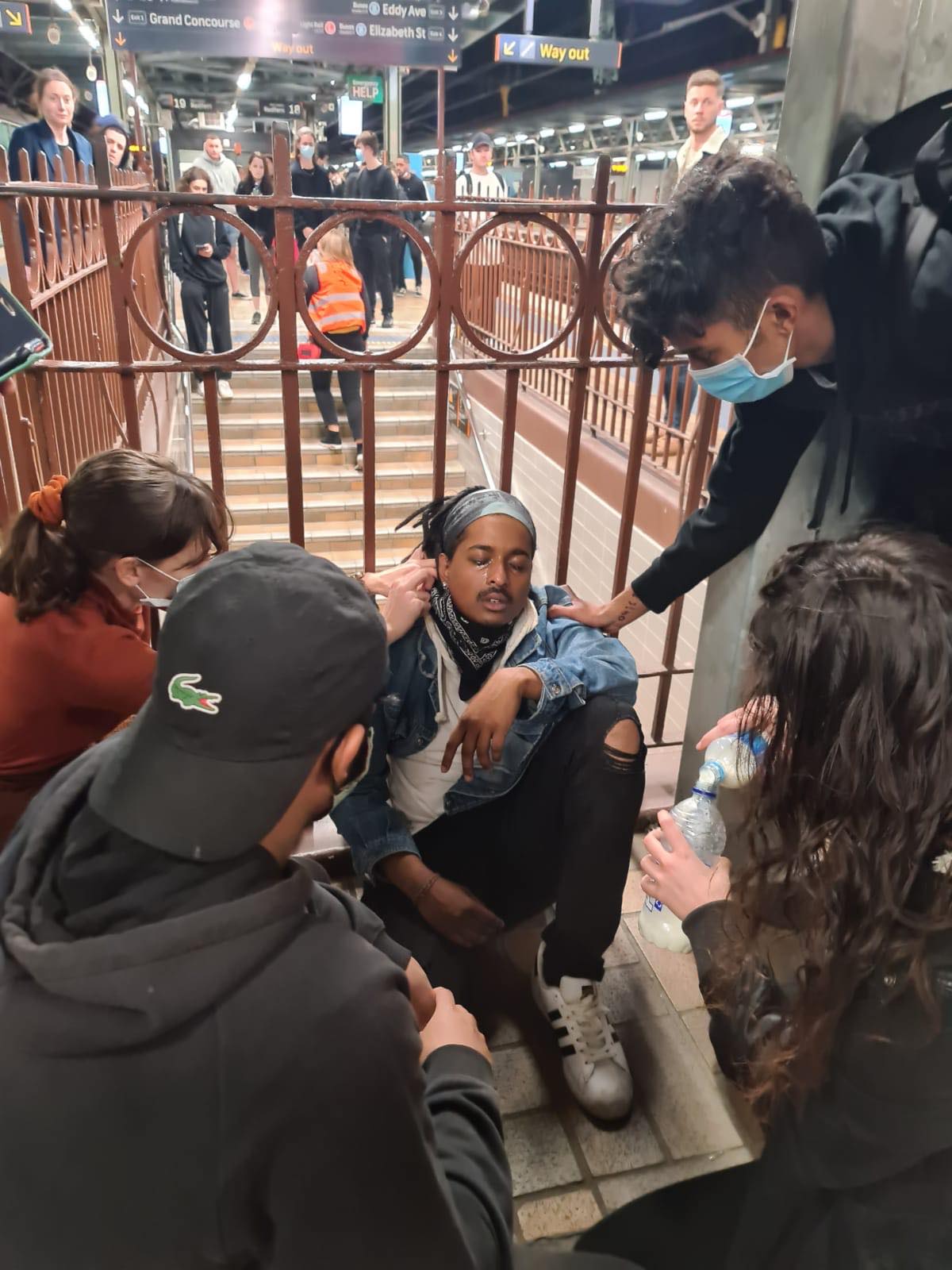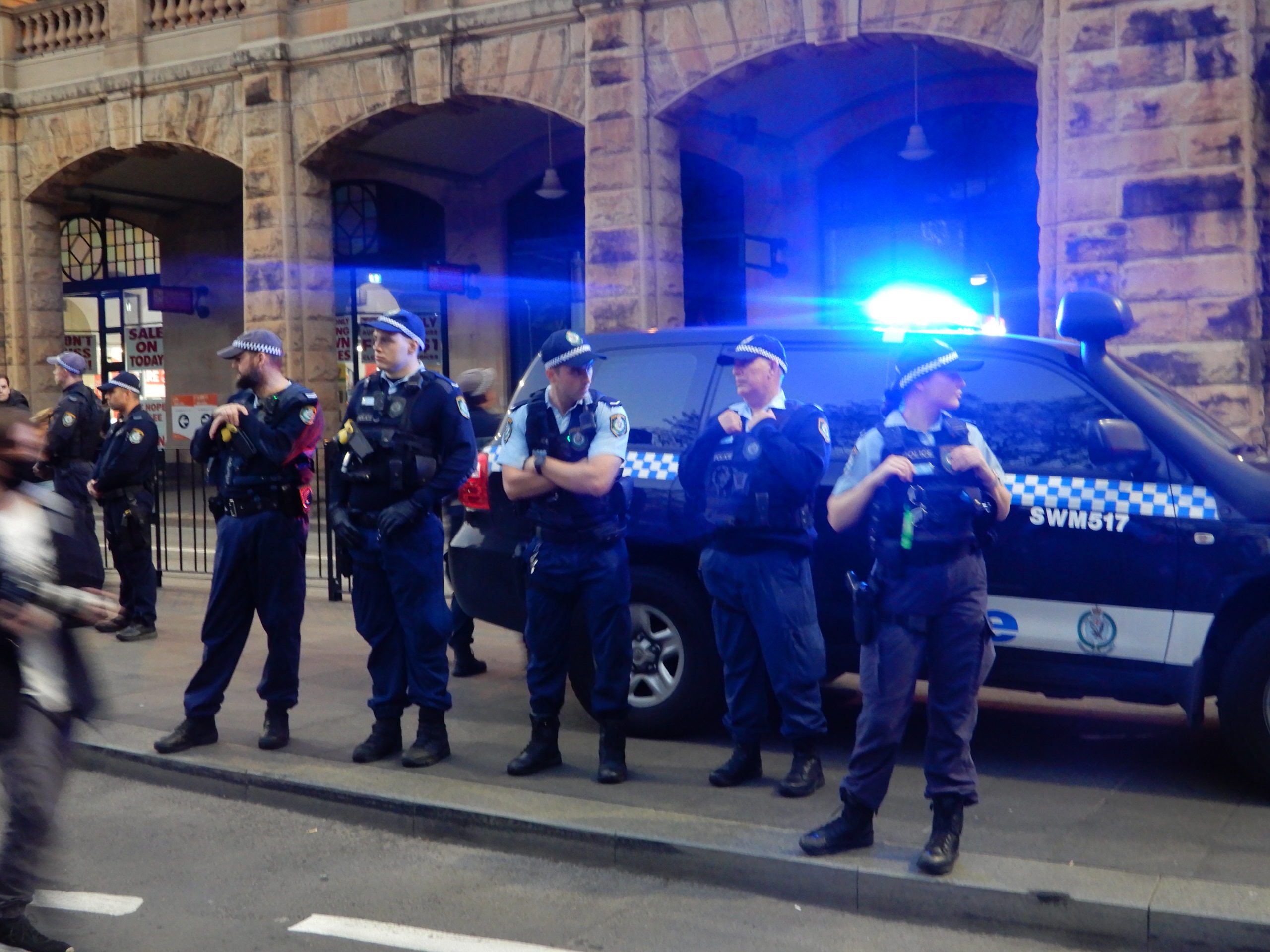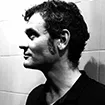A large protest march against police violence towards First Nations people was never going to be the top of the NSW police commissioner's wish list.
Indeed, some presume that's why Mick Fuller moved to have the NSW Supreme Court shut down the Stop All Black Deaths in Custody march. However, on 6 June, despite the court ruling it was unlawful, a startlingly large crowd gathered at Sydney Town Hall.
About 20 minutes before the protest was set to commence, NSW Greens MLC David Shoebridge announced that an appeal of the decision was successful, and the rally was now legal.
David Dungay Junior's family lead the procession down Castlereagh Street. The demonstration marked the young Dunghutti man's death at the hands of prison guards at the hospital wing of Sydney's Long Bay Gaol back in December 2015.
Couldn't help themselves |
It was obvious to those present that organisers at the 6 June protest were taking particular care to ensure the march was peaceful.
It was a rally calling for an end to systemic brutality against First Nations people, and not an excuse to engage in any violence. And as the crowd dispersed, most attendees felt a level of solemnity about what had just transpired.
But, only an hour later, posts began appearing on social media reporting that a number of NSW police officers had set upon a group of young people with pepper spray at Central Station's lower concourse.
ASEN (Australian Student Environment Network) state convenor Seth Dias was present at the scene of the police attack. Sydney Criminal Lawyers spoke to the university student about the actions of NSW police, and the help he and others provided to its victims.

Firstly, around 50,000 peaceful protesters left Belmore Park on Saturday afternoon. There were no incidents during the rally. Organisers had been extra vigilant to make sure there weren't. |
However, an hour later, the word on social media was NSW police officers had confronted demonstrators at Central Station and were tear gassing them. |
Seth, you were there. What actually happened? |
After the protest, Eddy Avenue was closed to make it easier to get to the station and the bus stop. It was so everyone could disperse easily. And a lot of people had gathered on the street, hanging about with very positive vibes.
It's important to remember that this was a crowd of predominantly teenagers or young people. They were just having a good time.
I was close to this gathering, when some chanting started. The police claim it was because something was thrown off the bridge.
But, I'm not entirely sure. I didn't see or hear anything like that. And as the chanting began, people organically started marching down Eddy Avenue.
Once we got to the corner with Pitt Street, we were met by a few police. And it began to get a bit more heated.
No protester behaved in a violent manner, but they were chanting things like "black lives matter" and "I can't breathe". And then, very quickly, the police applied a tactic known as kettling: where they surround the protesters and contain them.
They forced us off the road, which was unsurprising. But, once we were off the road and onto the footpath, we weren't doing anything, besides chanting.
I was at the front line and didn't see anyone move in an aggressive manner towards the police.
The officers continued to force us back off the path and into the station in a coordinated way. One would yell "forward" and they would all come at us, pushing us back. We didn't resist in any way. We just let ourselves be pushed.
There was no formal move on order given at any point. And they continued to push us back further and further into the station. They got particularly rough at the ticket barriers, which were difficult to get through.
Once we were inside the station, we had an informal sit-in and a few people gave some speeches. Then we decided we would go up onto platform 19 and take a train to Redfern and disperse there.
But, we looked up the stairs and they were closed. It then appeared that the steps to every platform had been closed.
So, we were trapped. There was nowhere we could go. At this point, we were still peacefully sitting down and wondering what to do. I began worrying as we couldn't get out.
Then people got back up. The chanting resumed. And the orange streams of pepper spray started being deployed.
It's very long. It hit a lot of people point blank: people that were perhaps less than a metre away from the officer using it.
Everyone turned and ran. They'd reopened the platforms at that point. So, we were able to get up onto platform 19.
I went back down. It was complete carnage. There was pepper spray all over the floor. People were clearly in extreme pain.
We carried a bunch of people up. A few others were able to exit the station with people who had been sprayed.

Is it true that a 14-year-old girl got sprayed? |
Yes. That's definitely true. We had a few street medics that were able to help. And one of them confirmed – a good friend of mine – that she sat with the 14-year-old for a few hours.
The girl had been sprayed point blank.
In your understanding, why did police act in this manner? |
They wanted the crowd to disperse because it was beyond the allocated protest time. They claimed in an article that people were behaving in a violent manner towards them.
That's very subjective. No one laid a hand on the police or each other. It's a bit of a bogus claim.
You were involved in nursing those who'd been teargassed for about two hours after the incident. What did that involve? And what sort of a state were these people in? |
They weren't in a good state at all. It varied. Some people just got the periphery of the spray, while others copped it up close.
The first person I carried up the stairs was in a dazed state. They looked like they were about to pass out.
Once we got them up the stairs and poured some milk into their eyes, they literally began to yell in quite a serious manner.
There was one woman I helped. She was 17 years old. She kept saying she was going to die. She said she was in extreme pain, and she'd never experienced anything like it before. Then there were others who were sobbing.
There were a few people who knew first aid that were assisting. It was me, my partner, a close friend and two of these medics running up and down the platform with milk and water.
So, you're talking about the police setting upon a group of predominantly teenagers and young people with weapons. How did that leave you feeling about the NSW Police Force? |
It left me feeling quite scared after seeing the violence police used in what was supposedly a legal manner. That was the first time I'd seen them use pepper spray.
It's an incredibly violent tool. It's like chemical warfare in many ways. So, to know that the people who are there to allegedly protect and serve will just deploy that when things were not remotely violent, and were quite safe, really disappoints and scares me.
In many ways, I feel like they wanted to create an incident following everything that happened earlier in the day, with the ban on the rally and then the successful appeal.
I didn't have particularly positive feelings about the police to begin with, but it definitely diminished then.
And lastly, you were there for the Stop All Black Deaths in Custody-Black Lives Matter rally. What did you think about how it went prior to the police attack? And how would you sum up the message that was conveyed? |
Prior to the incident, I found it one of the most inspiring rallies I've been to. And I've been to heaps over the last few years.
It was awesome to see the Black Deaths in Custody movement getting some traction here in Australia. And people are finally beginning to see the reality of what it is to be an Indigenous person living in Australia in modern times.
The fact that people are learning that there have been 432 deaths in custody since 1991, and no officers have been convicted, is really important.
I had heaps of friends who were there who aren't political in any way who said that they really took away a lot and were quite confronted. It made them angry and they want to see change.
The fact that police tried to stop it going ahead was the worst decision they made because I was in contact with the organisers of the rally, and they always forecast that maybe 5,000 people would show up.
But, the court case to prevent it was just free media and publicity for the rally and it led it to be ten times larger to what the organisers were expecting.
Photo of the scene supplied by Seth Dias |
The content of this article is intended to provide a general guide to the subject matter. Specialist advice should be sought about your specific circumstances.

